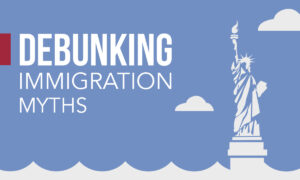 Earlier this week, I shared some thoughts on how we in the United States approach immigration. My overarching point in that post was that we rely far too heavily on enforcement and punishment, when we would be better served by having an immigration policy that is organized, streamlined, and well thought out, and which emphasizes respect, and compassion toward those seeking to enter the country. The post generated a few comments both on- and off-line, which prompted me to write this post clarifying some of the myths and misunderstandings regarding immigration.
Earlier this week, I shared some thoughts on how we in the United States approach immigration. My overarching point in that post was that we rely far too heavily on enforcement and punishment, when we would be better served by having an immigration policy that is organized, streamlined, and well thought out, and which emphasizes respect, and compassion toward those seeking to enter the country. The post generated a few comments both on- and off-line, which prompted me to write this post clarifying some of the myths and misunderstandings regarding immigration.
Alex Nowrasteh is the Vice-President for Economic and Policy Study at the Cato Institute, a libertarian think tank. He is an expert on immigration and has studied United States immigration policy for years. He offers 15 myths about immigration that I think a lot of people will find surprising.
MYTH #1: “Immigrants will take American jobs, lower wages, and especially hurt the poor.”
FACT: Immigrants don’t take American jobs, lower wages, or push the poor out of the labor market.
MYTH #2: “It is easy to immigrate here legally. Why don’t illegal immigrants just get in line?”
FACT: It’s very difficult to immigrate legally to the United States. Immigration law is second only to the income tax code in legal complexity.
MYTH #3: “Immigrants abuse the welfare state.”
FACT: Immigrants use significantly less welfare than native-born Americans.
MYTH #4: “Immigrants increase the budget deficit and government debt.”
FACT: Immigrants in the United States have about a net zero effect on government budgets — they pay about as much in taxes as they consume in benefits.
MYTH #5: “Immigrants increase economic inequality.”
FACT: Maybe. The evidence on how immigration affects economic inequality in the United States is mixed — some research finds relatively small effects, and some finds substantial ones. The standard of living is much more important than is the income distribution.
MYTH #6: “Today’s immigrants don’t assimilate as immigrants from previous eras did.”
FACT: Immigrants to the United States — including Mexicans — are assimilating as well as or better than immigrant groups from Europe over a hundred years ago.
MYTH #7: “Immigrants are a major source of crime.”
FACT: Immigrants, including illegal immigrants, are less likely to be incarcerated in prisons, convicted of crimes, or arrested than native-born Americans.
MYTH #8: “Immigrants pose a unique risk today because of terrorism.”
FACT: The annual chance of being murdered in a terrorist attack committed by a foreign-born person on U.S. soil from 1975 through the end of 2017 was about 1 in 3.8 million per year.
MYTH #9: “The United States has the most open immigration policy in the world.”
FACT: The annual inflow of immigrants to the United States, as a percentage of our population, is below that of most other rich countries in the Organization for Economic Cooperation and Development.
MYTH #10: “Amnesty or a failure to enforce our immigration laws will destroy the Rule of Law in the United States.”
FACT: America’s current immigration laws violate every principal component of the Rule of Law. Enforcing laws that are inherently capricious and that are contrary to our traditions is inconsistent with a stable Rule of Law.
MYTH #11: “Illegal immigration or expanding legal immigration will destroy American national sovereignty.”
FACT: Different immigration policies do not reduce the U.S. government’s ability to defend American sovereignty.
MYTH #12: “Immigrants won’t vote for the Republican Party — look at what happened to California.”
FACT: Republican immigration policies pushed immigrants away, not the other way around.
MYTH #13: “Immigrants bring with them bad cultures, ideas, or other factors that will undermine and destroy our economic and political institutions. The resultant weakening in economic growth means that immigrants will destroy more wealth than they will create over the long run.”
FACT: There is no evidence that immigrants weaken or undermine American economic, political, or cultural institutions.
MYTH #14: “The brain drain of smart immigrants to the United States impoverishes other countries.”
FACT: The flow of skilled workers to rich nations increases the incomes of people in the destination country, enriches the immigrants, and helps (or at least does not hurt) those left behind.
MYTH #15: “Immigrants will increase crowding, harm the environment, and [insert misanthropic statement here].”
FACT: People, including immigrants, are an economic and environmental blessing and not a curse.
These 15 myths were taken from Nowrasteh’s report, The Most Common Arguments Against Immigration and Why They’re Wrong. There’s a lot of other interesting information in the report that contradicts most of what you hear from Republicans in Congress, despite the fact that the Cato Institute and Republicans often agree on legislation.
Nowresteh offers a three-prong approach to immigration reform:
- Expand guest worker visas beyond agriculture
- Welcome all highly skilled immigrants
- “Enforcement First” is a cop-out and will never solve the immigration problem
The following video lays out Nowresteh’s recommendations. I not only found his recommendation to make sense, but I was surprised by who agreed with him once upon a time, only to now advocate against those same common sense immigration reforms.
